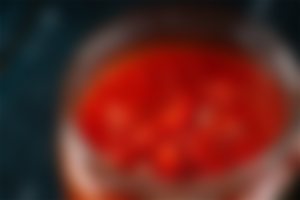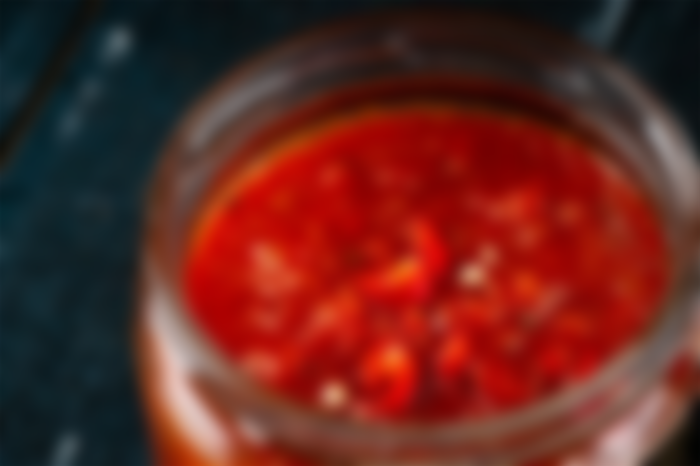When you see/experience how easy it is to make hot sauce at home, you will not easily buy hot sauce from the market again.
this year, I got the most natural jalapeño peppers grown in the garden. Among them, there were both ripe, red colored ones and not yet fully matured green colored ones. While I was thinking about what I should do and put it in a form that can be consumed all year long, I was eager to make hot sauce and after experimenting with small amounts, I reached two different favorite recipes using two different methods. I will give the recipes in kilograms in order to be a straight account. you can scale it according to the size of the jar or container you have, I think around 250-300 grams is ideal.
1. recipe
Our first method includes fermentation, so there will be 15-20 days between the time you start the recipe and the moment you taste the final product. Those who want to achieve faster results can switch to the second tariff.
materials
* 1 pound red, ripe jalapeño, or another type of hot pepper or chili peppers
* 1 liter of 2-5% brine (I use 5%) / brine (20-50 grams of salt per 1 liter of drinking water)
* 6 cloves of garlic (optional)
* vinegar (optional)
preparation of
* After washing the peppers, we separate the stems and cut them into pieces about the size of a finger knuckle. At this stage, if you separate the seeds of the pepper and the white part to which the seeds are attached, you will get a less hot sauce at the end, I prefer not to separate them.
Warning: When dealing with hot peppers such as jalapeño, chile pepper, cayenne pepper, etc., you should either wear gloves or not apply to any thin-skinned area before washing your hands, otherwise be prepared to burn that area for a while. do not always feel safe after washing once. Some peppers can burn unbelievably even after a wash or two.
* We take the smashed peppers into the jar / container where we will ferment them, add enough salty water to cover them and close the lid tightly. If you wish, we can add the peeled garlic at this stage, but I do not add it because I do it without garlic.
Note: If you disinfect the materials (cutting board, knife, etc.) that will touch the peppers and the container where the fermentation will take place, you will prevent unwanted microorganisms during fermentation. You can boil everything classically, or if you are making beer or wine at home, you can also use the star yellow chemical you use there.
* As some of the peppers will float, our salt water will not be able to cover all of them. I used a fresh vine leaf to compress and submerge the peppers, but instead you can get help from plastic tools designed for the job, glass pickle weights, or any heavy object you can fit into a jar.
* We leave our sealed jar in a place out of the sun and at room temperature to ferment for about 15-20 days or longer according to your preference. If you can put an airlock on the jar lid, it will be great, but if you do not have it, you will have to open the lid every day and miss the accumulated gases. If you encounter a layer like white film in this process, you can take it with the help of a spoon and continue fermentation, but if you see mold, something went wrong and this jar will go to the trash.
* Taste it after about 2 weeks. If it reaches the taste and sourness you want, you can proceed to the next step. I prefer to ferment mine for 20 days.
* After you reach the taste you want, strain the contents of the jar, but do not throw away the filtered water, we still have work to do with it.
* Throw the drained peppers and other vegetables, if any, into the blender. Add 250 ml of the filtered water to the blender and blend until you reach the desired consistency. You can reduce the amount of liquid if you want it to be thicker, or increase the amount of liquid for a more liquid sauce.
* If you want your sauce to have no particles, you can pass it through a fine strainer and get a consistency like tabasco sauce. Do not throw away the pulp remaining in your hand after straining. If you have a fruit/vegetable dehydrator, you can spread this remaining pulp on a tray about half an inch thick and then dry it at 50 degrees. After drying, you can pull it out and use it as a powdered spice. Especially the dried fermented sauces, which do not only consist of pepper, are wonderful for seasoning meat and chicken. For example, if you soak the chicken thigh cut into pieces with plenty of olive oil, dip it in the dried mixture and leave it for a day, you can have wonderful chicken skewers on the barbecue the next day.
* If the tartness is not enough or if you want to add different flavors, do not forget to add vinegar, lemon juice or various spices.
* Since our sauce is fermented, its pH will probably be below 4.6 and it will be suitable for storage without going into the refrigerator, but if you do not have a pH meter, there is no need to risk it, just throw it in the refrigerator. Since fermentation still continues in this state, if you are not going to store it in the refrigerator, stop the fermentation with heat treatment.

let's go to the second method
materials
* 1 kilo green jalapeño peppers or any cayenne pepper of your choice
* 1 onion
* 4 cloves of garlic
* 360 ml white vinegar
* 240 ml of water
* Juice of 2 limes (or 2 small lemons)
* 1 teaspoon of salt
* half a teaspoon of cumin
* half a teaspoon of coriander
* freshly ground black pepper
*** teaspoon is not a classic Turkish teaspoon, it is a teaspoon used for measuring (5 ml)
preparation of
* Roughly chop the onion and garlic and fry them in a pan with a little olive oil until soft. This step is one of the steps that can change the taste of the final product, if you wait until the onions are slightly caramelized, not soft, the final product will be slightly sweeter (I do it like this) no, if you say that I don't caramelize, then the onion flavor will be more dominant.
* While the onions and garlic are in the pan, we wash our jalapeño peppers, cut the stem and then roughly chop them.
* When the onions and garlics soften slightly and start to change color, we throw our spices -spices are completely up to you, the amount can be increased or decreased, different spices can be used, whatever your heart desires- and lightly roast them with onions and garlic so that the smell comes out. When the smell of spices comes out, we add our chopped and chopped peppers, water, vinegar -you can use any vinegar you want instead of white-and salt into the pan.
* We are waiting for all this mixture to boil until it boils. As soon as it boils, we pour all the ingredients into a blender.
* Add the lemon juice to the blender and grind it until it reaches the consistency you want. For example, I shoot it in a way that it is not thin, but slightly fragmented. Then I bottle half of this mixture directly while filtering the other half. I take the drained liquid hot sauce into a small sauce bottle and the remaining solid particles into a small jar. In this way, you have hot sauce in 3 different situations. You can use the solid one on bread while making a hot dog or hamburger, the liquid one can be used in liquid foods, and the particulate one can be used as a paste.
Many different sauces can be made by playing with this recipe. For example, I'm thinking of trying a hot sauce with honey or thyme by subtracting cumin and coriander, replacing it with thyme and honey, and replacing white vinegar with apple cider vinegar. There is a world of people on the internet who are obsessed with hot sauce and there are thousands of recipes, the only limit is your imagination.
enjoy your meal!
